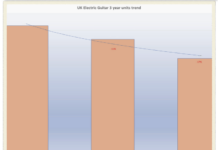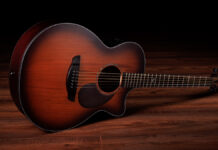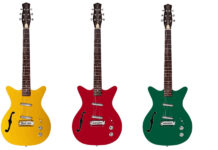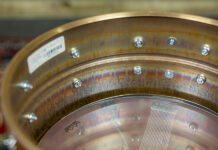
Review: Marshall DSL20C Amp
Call me old if you want. I don’t care. I got to see concerts by AC/DC with Bon Scott, Van Halen and Black Sabbath on the same stage, Pink Floyd’s original The Wall shows and much more. That said, the one thing that makes me jealous of younger generations is that there’s a lot of low-cost gear out there today that’s truly great, whereas it cost a small fortune to replicate the sounds of my favorite bands back when I was starting out playing guitar.
Marshall’s new DSL20 combo is a perfect example. It’s a versatile two-channel all-tube combo that delivers various flavors of classic, coveted Marshall tones, but it’s priced low enough for beginners to consider as their first amp. It doesn’t skimp on features either, which makes the DSL20C ideal for more experienced players who want more Marshall magic in their studio arsenal without robbing funds from their 401Ks.
FEATURES
The DSL20C is a 20-watt amp with an all-tube circuit featuring two EL34 power amp tubes and three ECC83 preamp tubes. A single Celestion Seventy 80 12-inch speaker rated 80 watts at 16 ohms is housed in the cabinet, which has a semi-open-back design with ports that keep bass frequencies tight and focused. The amp provides two individually voiced channels—Classic and Ultra—each of which has its own Gain and Volume controls and shares a single set of EQ controls (treble, middle, bass, presence and resonance) and a reverb level control. The EQ section also features a Tone Shift button that reconfigures the midrange frequencies. Full-(20-watt) and half-power (10-watt) settings are selected via the standby rocker switch, and a Channel Select switch lets users manually change channels when the footswitch controller (which is included with the amp) isn’t connected.
Rear-panel features consist of ¼-inch Send and Re turn jacks for the FX loop, a ¼-inch jack for the included footswitch, a 1/8-inch audio input, a 1/8-inch emulated output jack for sending audio to a mixer or recording interface and three ¼-inch speaker output jacks (a single 16-ohm output and one pair of outputs for 1×8-ohm speaker or 2×16-ohm speakers). The footswitch allows users to switch channels and engage or disengage the FX loop. The whole shebang is housed in a sturdy, roadworthy enclosure covered in textured black Tolex and featuring classic Marshall aesthetics like the white Marshall logo, gold control panel and knobs, white piping and black woven speaker grill cloth.
PERFORMANCE
Most guitarists have a pretty good idea of what classic Marshall tone is (or at least should be). For me, the DSL20C delivers exactly that. Of course, classic Marshall tone is actually a variety of tones, from crisp, snappy clean and percussive overdrive with just a hint of hair to roaring distortion with fat, punchy midrange and beefy, ballsy bass. The Classic channel delivers the former, but clean tone connoisseurs will want to stick with single-coil pickups as the tone starts encroaching on overdrive pretty early (with the Gain just above 9 o’clock) when using humbuckers.
The Ultra channel straddles a fine line between the most beloved Marshall tones of the late Seventies and Eighties and more modern high-gain textures. Although both channels share the same EQ controls, their basic tonal character is similar enough that they sound great no matter where the EQ is set; the difference between each channel is more a matter of gain. What really impressed me is how big the bass sounds and how the overall tone has a refined studio-like quality, as if Martin Birch and Mike Clink dialed in the finished sound.
LIST PRICE: $830
MANUFACTURER: Marshall Amplification, marshall.com
● Classic and Ultra channels deliver a variety of beloved Marshall tones from Malcolm-worthy crunch to Schenker-style distortion and beyond.
● The standby switch provides full (20-watt) or half (10-watt) power settings for full volume performance or lower volume recording and practice applications.
THE BOTTOM LINE
The classic Marshall tones we all know and love are delivered in abundance by the DSL20C, which makes it a killer studio secret weapon as well as a versatile tool for aspiring future guitar heroes.
Source: www.guitarworld.com










